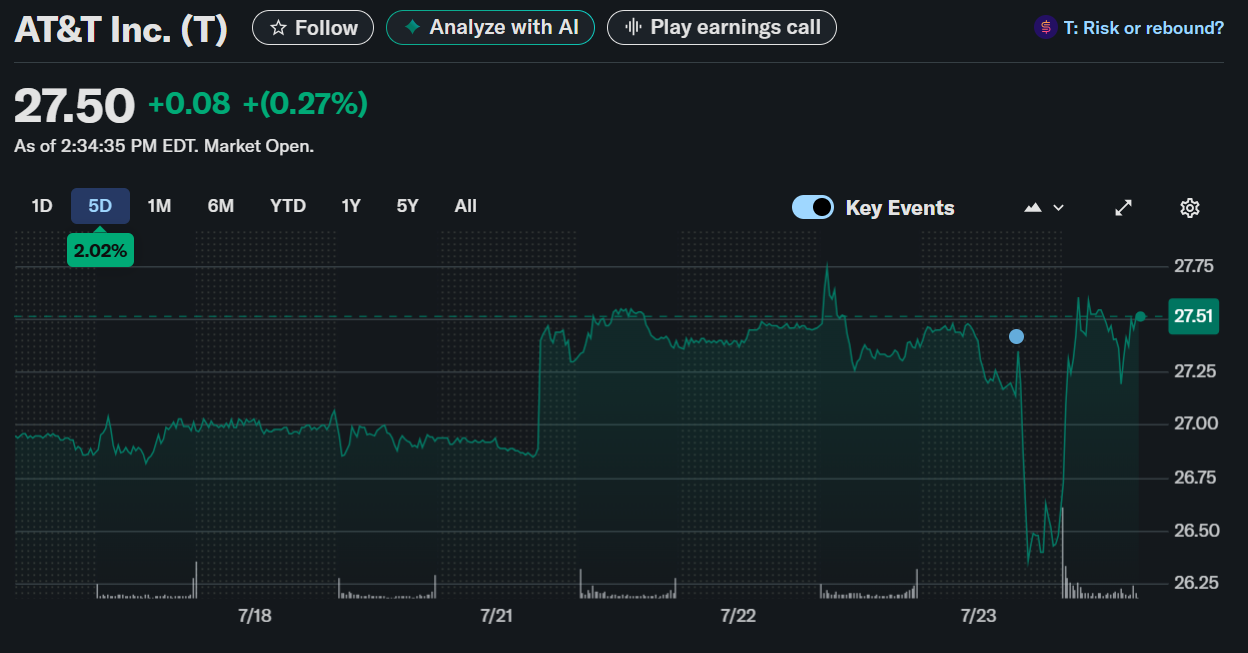TLDR
- AT&T added 401,000 net postpaid wireless subscribers in Q2, beating estimates
- Broadband connections rose by 150,000, tripling last year’s gains
- Revenue hit $30.8B, surpassing Wall Street expectations
- Company to invest $3.5B of tax savings in fiber infrastructure
- Free cash flow guidance raised to $16B+ for 2025
AT&T Inc. (NYSE: T) stock is trading at $27.71, reflecting investor confidence following a stronger-than-expected second-quarter earnings report.

The telecom giant reported solid subscriber additions in both wireless and broadband segments and detailed its strategic investments in fiber build-outs, thanks to anticipated tax savings from the newly enacted “One Big Beautiful Bill Act.”
Subscriber Growth Exceeds Expectations
The company added 401,000 postpaid wireless phone subscribers, beating the FactSet analyst estimate of 302,600. Though slightly down from the 419,000 added a year earlier, the figure signals continued strength in AT&T’s wireless offering. Broadband also saw healthy gains with 150,000 net additions, driven mainly by fixed wireless growth. Consumer fiber net adds reached 243,000, while AT&T Internet Air added 203,000 customers.
Financial Highlights and Guidance Update
Revenue for the quarter rose 3.4% year-over-year to $30.8 billion, exceeding analyst expectations of $30.5 billion. Net income attributable to common stock rose to $4.5 billion, up from $3.5 billion last year. Diluted EPS reached $0.62, while adjusted EPS stood at $0.54, up from $0.51 in Q2 2024. Free cash flow came in at $4.4 billion, marking an increase from $4.0 billion a year earlier.
With stronger operations and tax windfalls, AT&T raised its 2025 free cash flow forecast to the low-to-mid $16 billion range, and expects $18 billion+ in 2026 and $19 billion+ in 2027.
$8 Billion Tax Windfall Sparks Aggressive Fiber Push
A major driver of AT&T’s growth plan is the estimated $6.5 to $8.0 billion in tax savings between 2025 and 2027 from the recent tax legislation. AT&T plans to invest $3.5 billion of that into fiber network expansion, targeting over 60 million fiber locations by 2030, up from its previous projection of “about 60 million.”
This revised outlook incorporates the expected acquisition of Lumen Technologies’ Mass Markets fiber business and expansion through commercial partnerships like Gigapower. Another $1.5 billion from tax savings will go toward AT&T’s pension fund, with the remainder earmarked for capital returns and debt reduction.
Competitive Edge in Connectivity
CEO John Stankey emphasized the strategic momentum, noting the alignment of policy incentives, regulatory rollbacks, and spectrum opportunities. He cited AT&T’s growing edge in both wireless and fiber as a key differentiator. The company’s performance contrasts sharply with Verizon, which lost 9,000 net postpaid subscribers during the same period.
Outlook Through 2027
AT&T reaffirmed its commitment to low-single-digit revenue growth, 3%+ adjusted EBITDA growth, and double-digit EPS growth in 2027. Capital investment for 2025 is expected to total $22–$22.5 billion, increasing to $23–$24 billion in 2026–2027. With strong Q2 performance and new investments in place, AT&T appears well-positioned to lead in both wireless and fiber connectivity in the years ahead.






